ISSN ONLINE(2319-8753)PRINT(2347-6710)
ISSN ONLINE(2319-8753)PRINT(2347-6710)
Mohammad Zaheeruddin1, Dinesh Kumar G2
|
| Related article at Pubmed, Scholar Google |
Visit for more related articles at International Journal of Innovative Research in Science, Engineering and Technology
In combustion process pollutant emissions have become great public concern due to their effects on health and the environment. The exhaust from an aircraft gas turbine is composed of oxides of nitrogen (NOx) ,carbon monoxide (CO), carbon dioxide (CO2), water vapour (H2O), unburned hydrocarbons (UHC), particulate matter (mainly carbon). NOx is the by-product of complete combustion. High temperatures lead to formations of pollutants such as oxides of nitrogen (NOx) It is majorly formed by four methods namely: Thermal NO, Nitrous Oxide Mechanism, Prompt NO and Fuel NO. NOx is toxic in nature and mainly causes Acidification and Tropospheric Ozone formation by photochemical reaction with oxygen. In this project, NOx is estimated for biofuel manufactured from Algae, which has a greater scope of being used as replacement for fossil fuels. NOx emission for Algae biodiesel is analysed using Fluent.
Keywords |
| NOX emission, Algal oil, Equivalence ratio. |
INTRODUCTION |
| Oxides of nitrogen are called NOX. During combustion, NOX is formed by two methods. NOx emission formed through the oxidation of nitrogen in fuel is called fuel NOx and formed through oxidation of a portion of the nitrogen contained in the air in combustion chamber is called thermal NOX. Thermal NOX is formed at high temperatures. Though NOX emission from aviation industry constitutes only 2% of the total emissions but pose a serious concern as it causes acid rains and depletion of ozone layer. Various methods are available for control of NOX emission. The method used in this paper is temperature control. The main objective of this paper is to control NOX emission using biofuel. Reactions based upon Zeldovich mechanism for thermal NOx: |
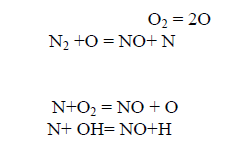 |
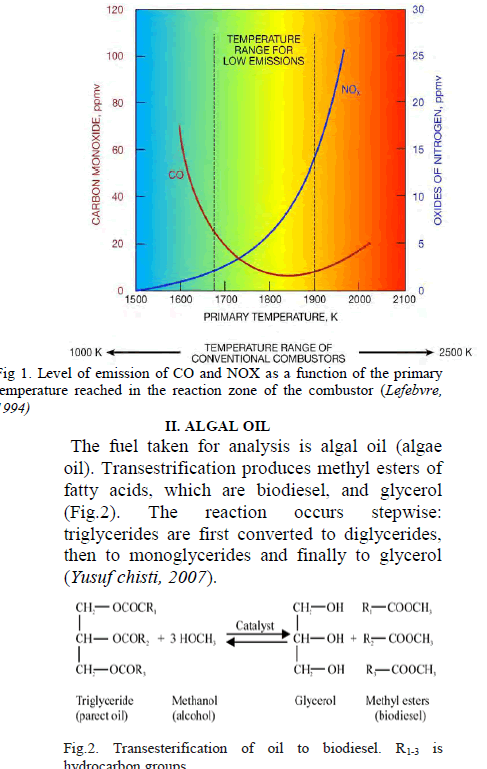 |
| Biodiesel is a proven fuel. Technology for producing and using biodiesel has been known for more than 50 years (Yusuf Chisti, 2007). The table shows the properties of algal oil which are nearly equivalent to the petro-diesel oil. |
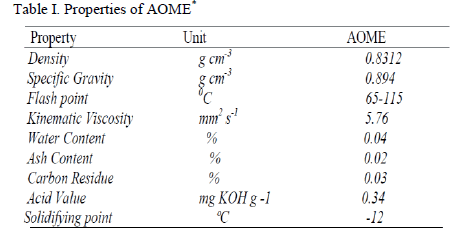 |
III. GOVERNING EQUATIONS |
| A. Species Transport Equations |
| The local mass fraction of each species, Yi, through the solution of a convection-diffusion equation for the ith species is given by the conservation equation: |
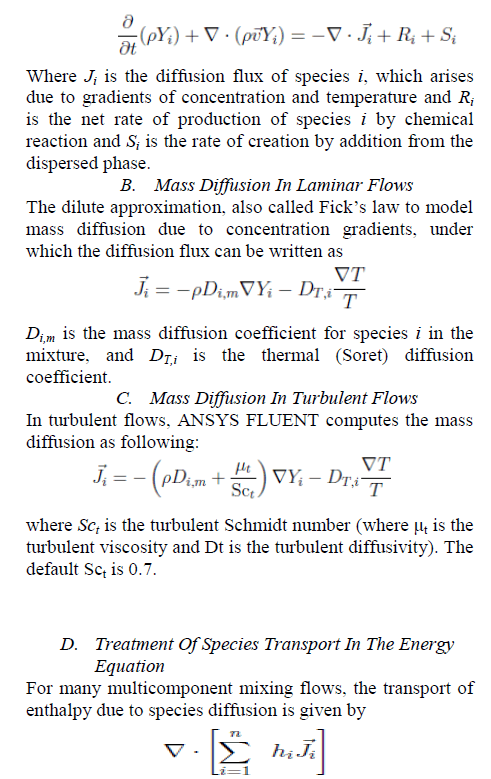 |
 |
| k is the thermal conductivity. |
| E. Diffusion at Inlets The net transport of species at inlets consists of both convection and diffusion components. The convection component is fixed by the inlet species mass fraction. The diffusion component, however, depends on the gradient of the computed species field at the inlet. F. The Generalized Finite-Rate Formulation for Reaction Modeling Laminar finite-rate model: The effect of turbulent fluctuations is ignored, and reaction rates are determined by Arrhenius kinetic expressions. • Eddy-dissipation model: Reaction rates are assumed to be controlled by the turbulence, so expensive Arrhenius chemical kinetic calculations can be avoided. The model is computationally cheap, but, for realistic results, only one or two step heat-release mechanisms should be used. • Eddy-dissipation-concept (EDC) model: Detailed Arrhenius chemical kinetics can be incorporated in turbulent flames. Note that detailed chemical kinetic calculations are computationally expensive. G. The Eddy-Dissipation Model In premixed flames, the turbulence slowly mixes cold reactants and hot products into the reaction zones, where reaction occurs rapidly. In such cases, the combustion is said to be mixing-limited, and the complex and often unknown, chemical kinetic rates can be safely neglected. The eddy-dissipation model is given by: |
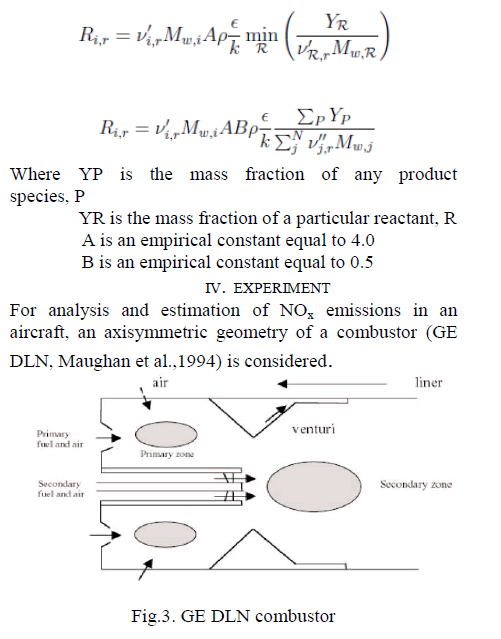 |
| The grid used in this simulation is generated using Gambit. Analysis is formed using Fluent. Cells are clustered close to the corner to capture expansion of flow. Premixed fuel-air is used in this combustor. The operating mode is lean-lean as the primary and secondary zones operate at low equivalence ratio and it also can raise turbine output to base load. The venturi prevents flashback as it accelerates as it has a converging – diverging geometry. The combustor operable temperature considered is in the range of 1500-1700 k. The equivalence ratio (ÃÂä) of algal oil is 0.91. Mixture of algal oil and air is used. |
| A. Boundary Conditions |
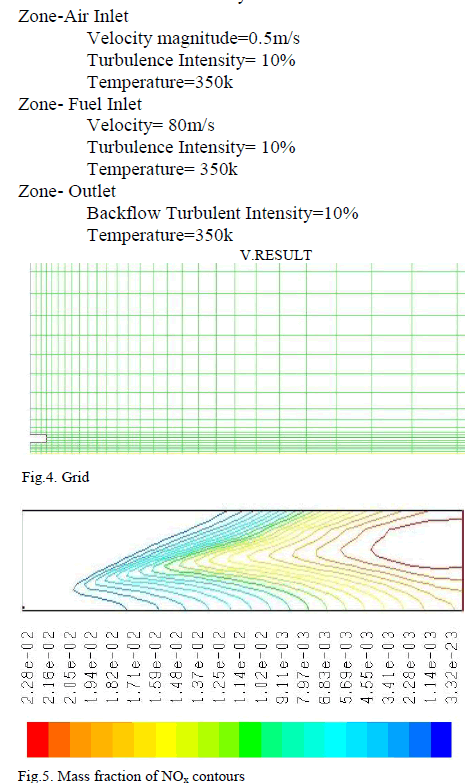 |
| The contour of mass fraction shows that formation of NOx is high at the exit of the combustor when compared to combustion zone. This is because in the combustor the temperature is being maintained in the range of low NOx emission. |
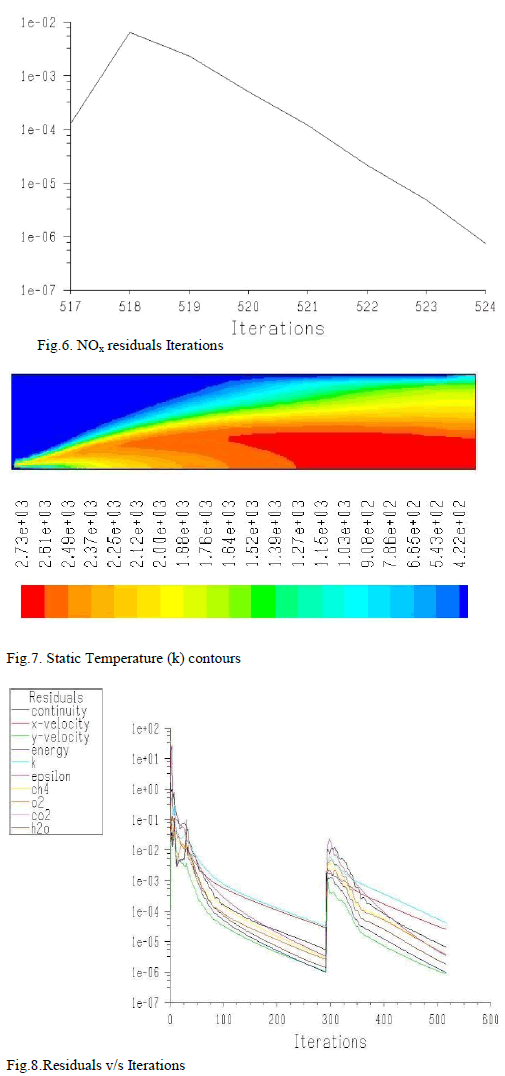 |
| The premixed fuel-air is combusted in the combustor. The contours show that the temperature is high in the combustion zone. |
VI.CONCLUSION |
| This paper is a work on NOx emissions in aircraft engines using algal oil. This paper shows that in thermally stable combustors the NOx emissions are low compared to high temperature varying combustors. It also supports algal oil as the best alternate fuel to fossil fuels which are costlier and much pollution causing fuels. |
References |
|